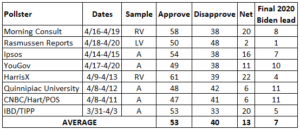For succinct take on President Biden’s first address to congress, try E. J. Dionne, Jr.’s “Biden’s speech was bipartisan and partisan at the same time,” in which he writes “President Biden on Wednesday night went big, populist, folksy, hopeful, urgent — and bipartisan and partisan at the same time. Addressing a pandemic-reduced gathering of lawmakers at the Capitol, Biden proposed a sweeping program of change that would create four more years of free schooling, expand child care and family leave, and attempt to beat back climate change through large infrastructure investments….He pressed for police reform — to “rebuild trust between law enforcement and the people they serve” and “root out systemic racism” — as well as broad reforms to political and voting rights, big repairs to the immigration system, and new gun-control measures….Biden welcomed the help of Republicans again and again, but he took clear aim at their favored economic doctrines. “My fellow Americans, trickle-down economics has never worked,” he declared. “It’s time to grow the economy from the bottom up and middle-out….And he took a victory lap on progress against covid-19, proclaiming that widespread vaccinations were offering “a dose of hope.”….This address wasn’t exactly the New Deal or the Great Society, but it was equally ambitious. Biden, reassuringly unradical with his plain, avuncular demeanor, is bidding to create a new common sense rooted in political lessons that Democrats have learned the hard way….Calling his American Jobs Plan “a blue-collar blueprint to build America,” he noted that nearly 90 percent of its infrastructure jobs “do not require a college degree” and that “75 percent don’t require an associate’s degree.”….And in a deft bit of political jujitsu, he touted his proposed investments in alternative energy to fight climate change as a form of economic nationalism. “There’s no reason the blades for wind turbines can’t be built in Pittsburgh instead of Beijing. . . . No reason why American workers can’t lead the world in the production of electric vehicles and batteries.”
But Tim Nichols’s “Biden message to China and Russia: America is back, Trump is gone, the free ride is over” at USA Today focused on America’s more assertive role in the world under his administrion: “Joe Biden’s speech to Congress was the first time in four years that people who focus on foreign policy and national security have had to pay attention to a presidential address. There was actually a recognizable foreign policy in it, a statement of principles about democracy and America’s role as a global leader, from a functioning White House that seems to care about engagement with the rest of the world….Unfortunately, one of Biden’s clear themes on foreign affairs was his recognition of the destruction former President Donald Trump left in his wake and the need to restore American credibility. The past four years were good days for the world’s dictators and other miscreants, and Biden on Wednesday night began the job of making a case for restoring America’s alliances, of defending American ideals, and of warning off the various wolves that have circled the democratic camp while the American lanterns were dimmed….While Biden is concerned about China, he is openly angry about Russia and what Vladimir Putin’s Kremlin was allowed to get away with for the past four years. (Trump had only one truly consistent policy in his time in office, and it was to avoid antagonizing Moscow at all costs, a humiliating obsession that was driven by Trump’s obvious and paralyzing personal fear of Putin.)….Biden on Wednesday night began the job of making a case for restoring America’s alliances, of defending American ideals, and of warning off the various wolves that have circled the democratic camp while the American lanterns were dimmed.”
From “James Carville says Democrats ‘don’t have the votes’ to be ‘more liberal’ than Joe Manchin” by John L. Dorman at Business Insider: “The longtime Democratic strategist James Carville knows a thing or two about winning an election. As the chief strategist of former President Bill Clinton’s successful 1992 campaign, he helped the Democratic Party end a 12-year streak of GOP control of the White House….In a recent Vox interview, Carville pushed back against suggestions from some Democrats that the party, no matter the consequences, should be passing its highest-priority legislation since it has control of the House and Senate….Carville spoke of Sen. Joe Manchin, the moderate West Virginian who opposes axing the filibuster and has called for more bipartisan cooperation on President Joe Biden’s proposed infrastructure bill, in arguing that the party currently has a limit for what it wants to pursue….”The Democratic Party can’t be more liberal than Sen. Joe Manchin,” he told Vox. “That’s the fact. We don’t have the votes.” Despite the disappointment of more progressive Democrats in Manchin, he has recently affirmed his loyalty to the Democratic Party, which is good news for everyone who opposes restoring Mitch McConnell’s one-man veto of all legislation he dislikes.




